Module 3
1. Module 3
1.32. Page 3
Module 3—Electrical Phenomena
 Lesson 5 Lab: Storing Energy in Non-Uniform Electric Fields
Lesson 5 Lab: Storing Energy in Non-Uniform Electric Fields
There are two parts to this Lab activity. The first part is a simulation that examines how a charged particle behaves in a non-uniform electric field due to the force caused by the field. The second part is a simulation that examines the energy transfer from kinetic energy and potential energy between the charged particle and the non-uniform electric field.
Part A: Motion in a Non-Uniform Electric Field
Purpose
In this part of the lab activity you will use a computer simulation to collect data enabling you to answer the following questions:
- How does a test charge move in a non-uniform electric field?
- How can this motion be explained using physics principles?
Procedure
Step 1: You may be required to enter a username and password. Contact your teacher for this information. Open the Electrical Field Potential, Non-Uniform simulation, and enter the following settings:
- Reset the simulation (
 ). Note that the source is the larger charge on the left and the test body is the smaller charge on the right.
). Note that the source is the larger charge on the left and the test body is the smaller charge on the right.
- Turn on the grid (
 ).
).
- Click on the “velocity mode” button (
 ) until the velocity is displayed in the polar method (
) until the velocity is displayed in the polar method ( ), showing a velocity in m/s and a direction in degrees.
), showing a velocity in m/s and a direction in degrees.
- Drag the test charge to the following location: (x,y) = (100,0).
- Click on the “initial” button (
 ) to have this position be the point where initial values are determined.
) to have this position be the point where initial values are determined.
- Note that if you use the “rewind” button (
 ), you can return to these initial settings at any time during this lab activity. However, if you choose to reset (
), you can return to these initial settings at any time during this lab activity. However, if you choose to reset ( ), you will have to re-enter all these initial settings.
), you will have to re-enter all these initial settings.
If these settings have been applied, the screen should look like this.
Step 2: Collect the following data from the screen, which you will use in the Analysis:
qsource= __________ qtest= ____________
mtest= ___________
Step 3: Press “play” (![]() ), and observe the motion of the test charge until it reaches the point (x,y) = (300,0). Then press the “pause” button (
), and observe the motion of the test charge until it reaches the point (x,y) = (300,0). Then press the “pause” button (![]() ). Record the final velocity for the particle once it has reached this point. You will use this value in the Analysis.
). Record the final velocity for the particle once it has reached this point. You will use this value in the Analysis.
![]() = ___________
= ___________
Analysis
 Self-Check
Self-Check
SC 1.
- Describe the motion of the test charge as it moved from (100,0) to (300,0).
- Explain the motion of the particle using Newton’s laws of motion.
- Draw a free-body diagram to show the force acting on the particle at the points (100,0) and (300,0).
- Explain how the source charge was able to exert a force on the test charge even though the particles were not touching.
SC 2.
- Calculate the magnitude and direction of the electric field of the source charge at the locations (100,0) and (300,0).
- Explain how your answers to the previous question demonstrate that electric field varies inversely to the square of the distance from the source.
SC 3.
- Use your values for electric field from SC 2.a. to calculate the magnitude and direction of the electrostatic force acting on the test charge at the locations (100,0) and (300,0).
- Use your answers from SC 3.a. to calculate the acceleration of the test body at the locations (100,0) and (300,0).
 Self-Check Answers
Self-Check Answers
SC 1.
- Since the velocity is increasing, the motion of the test charge is accelerated motion.
- The electrostatic force acting on the test charge pushes the test charge away from the source charge since both objects are positively charged. The electrostatic force is the only force acting on the particle; therefore, this force is an unbalanced force. According to Newton’s second law of motion, unbalanced forces cause objects to accelerate in the direction of the unbalanced force.
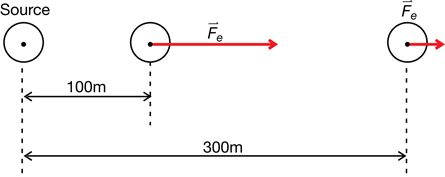
- The electric field of the source charge enabled it to exert a force on the test charge even though these charges were not touching.
SC 2.
a.
Given

Required
The electric field at 100 m, ![]() , and the electric field at 300 m,
, and the electric field at 300 m, ![]()
Analysis and Solution

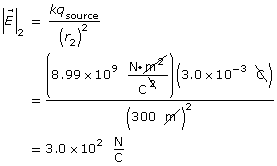
Since the source is positive, both electric field vectors are directed away from the source at an angle of 0°.
Paraphrase
- The electric field at the location 100 m to the right of the source is
 [0°].
[0°].
The electric field at the location 300 m to the right of the source is [0°].
[0°].
- The location that is 300 m from the source is three times further away than the location that is 100 m from the source. Therefore, the magnitude of the electric field is only
 as strong at the further location, compared to the closer location.
as strong at the further location, compared to the closer location.
SC 3.
a.
Given
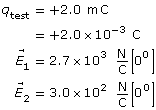
Required
The electrostatic force acting on the test charge at 100 m and at 300 m.
Analysis and Solution
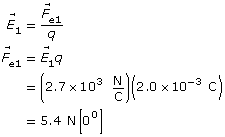
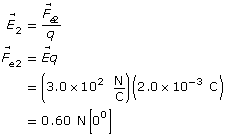
Paraphrase
- The electrostatic force on the test charge at (100,0) is 5.4 N [0°] and at (300,0) it is 0.60 N [0°].
b.
Given

Required
The acceleration of the test charge at 100 m and at 300 m.
Analysis and Solution
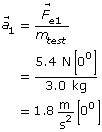
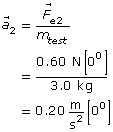
Paraphrase
The acceleration of the test charge at 100 m is 1.8 m/s2 [0°] and at 300 m it is 0.20 m/s2 [0°].
Part A Conclusion
 Module 3: Lesson 5 Assignment
Module 3: Lesson 5 Assignment
Remember to submit the answers to LAB 1 and LAB 2 to your teacher as part of your Module 3: Lesson 5 Assignment.
LAB 1. Describe the motion of a test charge in a non-uniform electric field.
LAB 2. Explain the motion of a test charge in a non-uniform electric field.